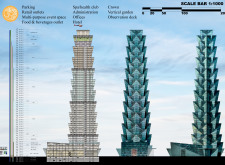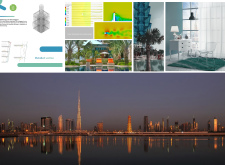5 key facts about this project
The Palm Skyscraper is located in Dubai, United Arab Emirates, within the Dubai International Financial Centre (DIFC). This building serves multiple purposes, including office spaces, hotel facilities, and areas for public use. The design reflects a strong emphasis on sustainability and strives to create a connection with the natural world. Inspired by the idea of a desert oasis, the project combines modern living with elements drawn from the surrounding environment.
Design Concept
The design concept centers around the theme of a desert oasis, representing a green area that provides a contrast to the dry surroundings. This notion resonates with Dubai's evolution from a barren desert to a bustling city. The Palm Skyscraper captures this journey by incorporating natural aspects into its architecture, fostering a sense of place that aligns with both the city’s history and its geographical context.
Sustainability Features
Sustainability is a key element in the design of the Palm Skyscraper. Vertical gardens are integrated into the structure, enhancing its visual appeal while also benefiting local flora and improving air quality. The building features windows that generate electricity using innovative liquid coatings, allowing them to harness sunlight for energy. This contributes to the overall energy efficiency of the building and supports a more sustainable approach to urban architecture.
Functional Diversity
The varied functions of the Palm Skyscraper are evident in its design, which merges different spaces for a range of uses. It combines offices, hotel accommodations, and areas for leisure, encouraging interaction among users and visitors. This thoughtful integration makes the skyscraper a vibrant place that caters to the needs of its community while enhancing urban life.
Architectural Integrity
The building reflects the resilient nature of palm trees, known for thriving in tough climates. This design choice emphasizes the qualities of stability and adaptability, which are essential for any structure in Dubai's climate. By drawing on the symbolism of the palm, the architecture not only reinforces its aesthetic appeal but also highlights a commitment to creating a structure that is both functional and responsive to its environment.






















































